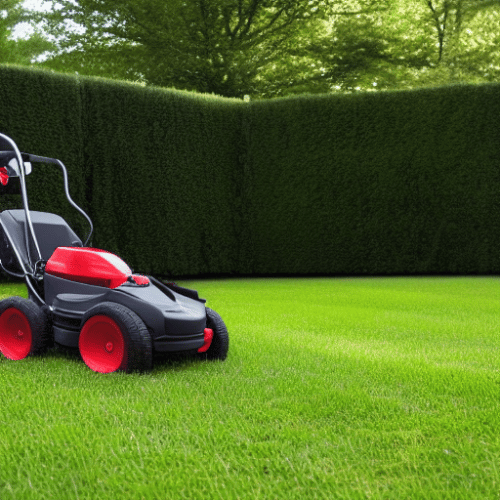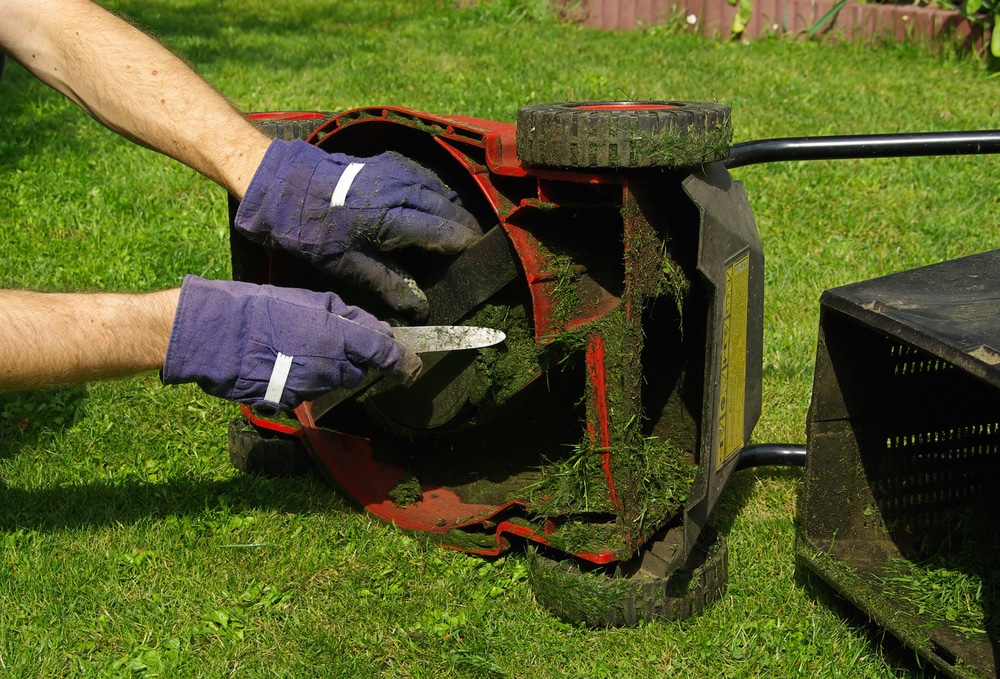Last Updated on
Servicing your lawnmower can improve your mower’s overall performance and extend its life span. At the beginning of each mowing season, you should inspect your lawnmower if you don’t use it frequently.
While you can take your lawnmower to a service and repair centre for a maintenance check-up, servicing it on your own is cheaper and just as good. You can also repair different parts if you have the necessary spare parts.
An unserviced lawnmower might not be quite effective in cutting grass in your garden and may not last for a longer time. In this post, we are going to show you how to service a lawnmower. We are also going to give you other maintenance tips that will help in the process.
The Complete Guide to Lawnmower Servicing
We have created a complete guide to lawnmower servicing. Let’s get started!
Change the Oil of the Lawn Mower Regularly
You need to change the engine oil of a lawnmower regularly for maximum efficiency.
For instance, you can change the engine oil after 50-60 hours of intensive use or when the oil level drops. On the other hand, if you don’t use your lawnmower regularly, you can change the oil annually. You can visit the official website of your mower to get some insight into the correct type of engine oil.
Keep these things in mind when you change the engine oil of your lawnmower:
- Before you start this procedure, you have to unplug the spark plug wire from the lawnmower. Unplugging the spark plug cable reduces the risk of any injuries.
- After unplugging the spark wire from the lawnmower, drain the engine oil by unfastening the drain plug located beneath the lawnmower. Note: some lawn mowers may not feature a drain plug, so an oil extractor kit might help you.
- Then, pour some new oil into the lawnmower until it gets to the same level as the dipstick full-mark line. Your lawnmower should have a good oil level to function effectively.
Replace or Clean the Air Filter Thoroughly
An air filter stops dirt particles and other debris from getting into the engine. If the air filter is faulty, dirt particles may pass through the filter and get into the engine. This will make your lawnmower relatively ineffective.
Here’s what you need to do when cleaning the air filter:
- Start by checking the type of air filter that is installed on your lawn. There are two types of air filters; foam air filters and paper air filters.
- After that, go through the user manual to know the type of pre-cleaner used while cleaning your air filter.
- Remove the spark plug wire and the air filters from your lawnmower.
- Clean the air filter by following the instructions found in the user manual. If your lawnmower has plastic foam filters, you can clean them with soapy water.
- Once you finish cleaning the air filters, let them dry out before reinstalling them.
Sharpen the Blades of the Lawn Mower

The blades of a lawnmower can come into touch with numerous objects, such as rocks and other garden dirt, and as a result, they can become blunt over time. Cutting grass with a lawnmower that has dull blades can be pretty hectic.
It would help if you sharpened the blade of a lawnmower regularly for maximum efficiency. Not to mention, you should sharpen it at the start of every summer season. A sharper blade cuts grass in a garden more easily than a blunt one.
You can use different tools to sharpen the blades of your lawnmower. Examples of such tools include files, drill sharpeners, and bench grinders.
While all tools are pretty effective, the drill sharpener sharpens a blade faster than the file.
To sharpen the blades of your lawnmower, follow these steps:
- Start by removing the blade from the machine. Mark the underside of the blade so that you can install it correctly after you sharpen it.
- If you plan to use a file to sharpen the lawnmower’s blade, you have to place it on the edge of the blade at a 45° angle and then slide it in a downward direction.
- Stroke the chiselled edge until it becomes sharp again. Maintain the same angle as you are sharpening the blade to ensure it is balanced and remains effective.
- Alternatively, you can use a drill sharpener to sharpen a blunt mower blade. Clamp the blade to a vice on a workbench.
- Connect the drill to a power source, then attach the grinding stone to the drill chuck.
- Place the grinding stone on the angled edge of the blade (the guide plate should rest on the flat side of the edge).
- After that, start your machine and move it along the edge of the blade. You can stroke it four to five times until it becomes completely sharp.
- Unclamp it and switch the sides.
- Sharpen the other side, following the same steps.
Treat the Fuel of a Petrol Lawn Mower
If you don’t use your petrol lawnmower regularly, the stored fuel might become old and ineffective. Engine oil often loses its functionality if it stays in the fuel tank for an extended period. Degraded fuel might affect your lawnmower negatively. Your petrol lawnmower may not function well if it’s running on degraded and old petrol.
Use a fuel stabilizer to preserve the quality of petrol.
If you had stored your petrol-powered lawnmower during the winter season, pour the fuel into the fuel tank and replace it with some fresh fuel.
Replace the Spark Plugs
It would help if you replaced your old spark plug with a new one at least once a year. You can change it at the start of a new mowing season.
- Unplug the spark wire, then use a wrench to remove the spark from your lawnmower.
- Take a picture of the code that is written on the spark. It will guide you as you are looking for a new spark plug.
- Apart from that, a user manual can also give you some insight into the type of spark plug that you should be using on your lawnmower.
- Once you find the correct spark plug for your lawnmower, fasten it to the lawnmower using a wrench or a pair of pliers.
Cleaning the Underside Part of the Lawn Mower
The underside of your lawnmower might have caked-on mud and other dirt particles, which could affect the overall performance of your lawnmower.
Cleaning your lawnmower is a maintenance procedure. Follow these steps to make sure you are cleaning your lawnmower properly:
- Before you start, you need to drain the fuel tank first. You can pour the fuel into a container and use it later.
- Turn the lawnmower upside down, then remove some of the caked-on mud that might be stuck on the base of your lawnmower.
- Use a wire brush to get rid of the particles that might be on your lawnmower.
- After that, use a pressure washer to wash the underside of the lawnmower. Scrub the deck gently with a soft-bristled brush. Rinse it and leave it to dry.
Other Mower Maintenance Tips
Here are some other maintenance tips that can help in keeping your mower in excellent condition.
Check the Essential Fastenings of Your Lawn Mower Regularly
Since the engine/motor vibrates vigorously, it can cause different fastenings (bolts and screws) to become loose. Due to this, you have to take a look at the essential fastenings after a particular time. If you find a loose fastening, tighten it.
Check Whether the Wheels Are in a Good Condition or Not
The wheels of a lawnmower can wear out after a certain period. If the wheels are not balanced, you might have a hard time cutting grass on your lawn.
Replace the Power Cable of an Electric Mower
Electric mowers come with a power cable used to transfer electricity from a power source to the central unit. While such cords are designed to last for a long time, they might wear out.
Using a mower that has an open wire can be pretty dangerous. You have to replace the cable once it wears out. Visit the official website of your mower to get some insight on the type of cord that you should purchase while doing a replacement.
Always check the length of the power cable before each use to ensure the plastic coating has not been damaged and is not loose at either end.
Countercheck Every Essential Part of Your Lawn Mower
You should check whether the essential parts of your mower are functioning correctly. If there is any damage to the crucial parts, make the necessary repairs.
Visit the official website of your lawnmower and check if they have some of the correct parts needed to make repairs. The website will also give you some insight into the type of essential spare parts you should use while fixing your lawnmower.
Different Types of Oil That You Should Use Based on the Season/Climate
While a lawnmower can operate on one type of oil, some oils can perform better in certain climates/seasons than other oils. Due to this, you have to be quite careful while replacing the oil in your lawnmower.
Here are the different types of oils that you can use on your lawnmower, depending on the climate:
- SAE 30 is suitable for warm climates and warm seasons. Not to mention, it performs well in small engines.
- Synthetic SAE 5W-30 is appropriate for different temperatures. SAE 5W-30 is suitable for a wide variety of climates.
- SAE 10W-30 should be used in places that have fluctuating temperatures.
- Vanguard 15W-50 is appropriate for different types of climates and can be used continuously. This type of oil is mostly used in commercial lawnmowers.
Service Your Lawnmower in Your Home
Well, you can efficiently service your lawnmower in the comfort of your home. Ensure that you check the essential parts, such as the blades, spark plugs, and air filters. Also, take a look at the engine oil. If you had used the oil for a long time, change it. You can purchase some of the service parts and equipment from the official website of your mower.
Follow these simple steps on how to service a lawnmower, and you can save yourself a few extra pounds while also gaining some handy knowledge.
Ian loves everything that revolves around the home improvement niche. He loves trying out new home appliances. He has also handled a lot of equipment and has a lot of insight. Plus, he’s worked on various home improvement projects that became a success.
If Ian isn’t busy working on his latest project, you can find him reading up about another one!



